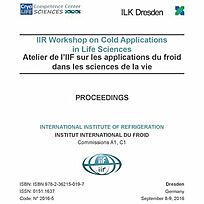
IIR document
Comparison of vitrification and slow freezing efficiencies of human zygotes.
Number: pap. 018
Author(s) : PETRUSHKO M. P., PYNYAEV V. I., YURCHUK T. A.
Summary
The use of cryopreservation of embryos in assisted reproduction technologies can not only reduce the occurrence rate of multiple pregnancies, but also increases the cumulative pregnancy rate, due to embryo transfer in any other cycle with no stimulation of superovulation. Due to this the cryopreservation procedures objective is to obtain a high rate of survival and viability of embryos after thawing, which largely depends on the choice of freezing method. Since one of the key parameters of cryopreservation protocols is the rate of cooling, the aim of this study was to compare the efficacy of slow freezing and vitrification of human embryos at the zygote stage. There was shown that the most effective zygote cryopreservation was at 18 hrs. after insemination, when 2 pronuclei were clearly visualized. At this time, the early zygotes were less sensitive to the damaging effects of freeze-thawing process than the zygotes were in G2 phase of the cell cycle, the stage which was prior to mitosis (26 hrs. after insemination). The further development of these zygotes was blocked. Our data are helpful in explaining the conflicting results about successful or failed cryopreservation of human embryos at the zygote stage.
Available documents
Format PDF
Pages: 4 p.
Available
Public price
20 €
Member price*
Free
* Best rate depending on membership category (see the detailed benefits of individual and corporate memberships).
Details
- Original title: Comparison of vitrification and slow freezing efficiencies of human zygotes.
- Record ID : 30019505
- Languages: English
- Source: 2nd IIR Workshop on cold applications in life sciences.
- Publication date: 2016/09/08
- DOI: http://dx.doi.org/10.18462/iir.cals.2016.0018
Links
See other articles from the proceedings (25)
See the conference proceedings
Indexing
-
Cryopreservation by vitrification: basic thermo...
- Author(s) : KATKOV I. I., BOLYUKH V. F.
- Date : 2017/05/15
- Languages : English
- Source: Cryogenics 2017. Proceedings of the 14th IIR International Conference: Dresden, Germany, Mai 15-19, 2017.
- Formats : PDF
View record
-
Low temperature photo pyroelectric study on the...
- Author(s) : MATHEW A., ESCORNE B., ELASS A., et al.
- Date : 2017/05/15
- Languages : English
- Source: Cryogenics 2017. Proceedings of the 14th IIR International Conference: Dresden, Germany, Mai 15-19, 2017.
- Formats : PDF
View record
-
Low- and high-temperature vitrification of livi...
- Author(s) : KATKOV I. I.
- Date : 2004/04/27
- Languages : English
- Source: Cryogenics 2004. Proceedings of the 8th Cryogenics Conference
- Formats : PDF
View record
-
Cryopreservation of mesenchymal stromal cells b...
- Author(s) : PETRENKO A. Ju., TRUFANOVA N. A., PETRENKO Ju. A.
- Date : 2012/09/11
- Languages : English
- Source: Cryogenics 2012. Proceedings of the 12th IIR International Conference: Dresden, Germany, September 11-14, 2012.
- Formats : PDF
View record
-
Cryopreservation of mutant mice.
- Author(s) : SCHENKEL J., DIERCKS A. K., STAUDT M., et al.
- Date : 2014/04/07
- Languages : English
- Source: Cryogenics 2014. Proceedings of the 13th IIR International Conference: Prague, Czech Republic, April 7-11, 2014.
- Formats : PDF
View record
